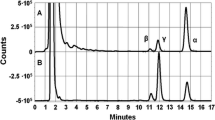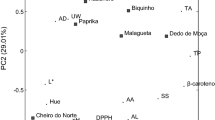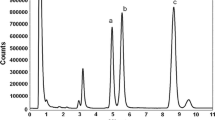Abstract
The cognition of original qualitative attributes of native Peruvian chili peppers elucidate their potential industrial exploitation. There is a lack of scientific information about chili pepper physicochemical and nutritional attributes, that hampers their immediate industrial use. Therefore, the aim of the present study was to characterize twenty Peruvian chili pepper landraces in terms of structural and nutritional properties. In particular, the Bostwick consistency index of chili purées, dry matter, dietary fibers and pectin content were determined. In addition, the color and carotenoid profile of each landrace were studied. A wide range of consistency and stability were found, and partially explained by the dry matter, dietary fiber and pectin content. C. annuum landraces displayed the highest dry matter and fiber content. Moreover, different carotenoid profiles were observed, being β-carotene the most abundant in almost all the samples. Capsanthin was present only in red landraces, while yellow ones had low total carotenoid content. High Retinol Activity Equivalent levels were determined for red peppers, while high insoluble dietary fiber level was found in all the samples. Cluster analysis, including all the chili pepper attributes, showed no relation between taxonomical classification and chili peppers structural, sensorial, and nutritional characteristics. Unique features of studied chili pepper landraces presented in this work should be considered during their industrial processing. In this context, these results might be considered a starting point for processing design and for the proper valorization of this raw material.




Similar content being viewed by others
References
FAO. FAOSTAT (Internet) (2018) Available from: http://www.fao.org/faostat/en/#data/QC. Accessed 30 Apr 2018
Bosland PW, Votava E (2012) Peppers. Vegetable and spice capsicums, 2nd edn. CABI, Wallingford, 230 p
Jäger M, Jiménez A, Amaya K (2013) Las cadenas de valor de los ajíes nativos de Perú. Compilación de los estudios realizados dentro del marco del proyecto “Rescate y Promoción de Ajíes Nativos en su Centro de Origen” para Perú. Bioversity International, Cali, p 90
Christiaens S, Mbong VB, Van Buggenhout S, David CC, Hofkens J, Van Loey AM et al. Influence of processing on the pectin structure-function relationship in broccoli purée. Innov Food Sci Emerg Technol (Internet). 2012;15:57. https://doi.org/10.1016/j.ifset.2012.02.011
Martínez R, Torres P, Meneses M, Figueroa JG, Pérez-Álvarez J, Viuda-Martos M Chemical, technological and in vitro antioxidant properties of mango, guava, pineapple and passion fruit dietary fibre concentrate. Food Chem (Internet). 2012;135:1520. Available from: https://doi.org/10.1016/j.foodchem.2012.05.057
McKee LH, Latner TA. Underutilized sources of dietary fiber: a review. Plant Foods Hum Nutr (Internet). 2000;55(4):285. https://doi.org/10.1023/A:1008144310986
Guzman I, Bosland PW, O’Connell MA. Heat, color, and flavor compounds in capsicum fruit. In: Gang DR, editor. The biological activity of phytochemicals (Internet). New York Springer; 2011. p. 109. Available from: https://doi.org/10.1007/978-1-4419-7299-6
Minguez-Mosquera MI, Hornero-Mendez D. Separation and quantification of the carotenoid pigments in red peppers (Capsicum annuum L.), paprika, and oleoresin by reversed-phase HPLC. J Agric Food Chem (Internet). 1993 Oct;41(10):1616. https://doi.org/10.1021/jf00034a018
Meckelmann SW, Riegel DW, van Zonneveld MJ, Ríos L, Peña K, Ugas R et al (2013) Compositional characterization of native peruvian chili peppers (Capsicum spp.). J Agric Food Chem (Internet). Mar 13;61(10):2530. https://doi.org/10.1021/jf304986q
Rodríguez-Burruezo A, González-Mas MC, del Nuez F (2010) Carotenoid composition and vitamin A value in Ají (Capsicum baccatum L.) and Rocoto (C. pubescens R. & P.), 2 pepper species from the Andean region. J Food Sci 75(8):S446. https://doi.org/10.1111/j.1750-3841.2010.01795.x
Rao A, Rao L (2007) Carotenoids and human health. Pharmacol Res 55(3):207. https://doi.org/10.1016/j.phrs.2007.01.012
Krinsky NI, Johnson EJ (2005) Carotenoid actions and their relation to health and disease. Mol Aspects Med 26(6):459
Schweiggert U, Kammerer DR, Carle R, Schieber A (2005) Characterization of carotenoids and carotenoid esters in red pepper pods (Capsicum annuum L.) by high-performance liquid chromatography/atmospheric pressure chemical ionization mass spectrometry. Rapid Commun Mass Spectrom 19(18):2617
Suzuki K, Mori M, Ishikawa K, Takizawa K, Nunomura O (2007) Carotenoid composition in mature Capsicum annuum. Food Sci Technol Res 13(1):77
Topuz A, Ozdemir F (2007) Assessment of carotenoids, capsaicinoids and ascorbic acid composition of some selected pepper cultivars (Capsicum annuum L.) grown in Turkey. J Food Compos Anal 20(7):596
Giuffrida D, Dugo P, Torre G, Bignardi C, Cavazza A, Corradini C et al. Characterization of 12 capsicum varieties by evaluation of their carotenoid profile and pungency determination. Food Chem (Internet). 2013;140(4):794. https://doi.org/10.1016/j.foodchem.2012.09.060
Kim JS, An CG, Park JS, Lim YP, Kim S. Carotenoid profiling from 27 types of paprika (Capsicum annuum L.) with different colors, shapes, and cultivation methods. Food Chem (Internet). 2016;201:64. https://doi.org/10.1016/j.foodchem.2016.01.041
Hornero-Méndez D, Mínguez-Mosquera MI (2000) Xanthophyll esterification accompanying carotenoid overaccumulation in chromoplast of Capsicum annuum ripening fruits is a constitutive process and useful for ripeness index. J Agric Food Chem 48(5):1617
Hornero-Méndez D, Gómez-Ladrón de Guevara R, Mínguez-Mosquera MI (2000) Carotenoid biosynthesis changes in five red pepper (Capsicum annuum L.) cultivars during ripening. Cultivar selection for breeding. J Agric Food Chem 48(9):3857. https://doi.org/10.1021/jf991020r
Guerra-Vargas M, Jaramillo-Flores ME, Dorantes-Alvarez L, Hernández-Sánchez H Carotenoid retention in canned pickled jalapeno peppers and carrots as affected by sodium chloride, acetic acid, and pasteurization. J Food Sci (Internet) (2001 66(4):620. https://doi.org/10.1111/j.1365-2621.2001.tb04611.x
Cervantes-Paz B, Yahia EM, De Jesús Ornelas-Paz J, Victoria-Campos CI, Ibarra-Junquera V, Pérez-Martínez JD et al. Antioxidant activity and content of chlorophylls and carotenoids in raw and heat-processed Jalapeño peppers at intermediate stages of ripening. Food Chem (Internet). 2014;146:188. Available from: https://doi.org/10.1016/j.foodchem.2013.09.060
Giuffrida D, Dugo P, Torre G, Bignardi C, Cavazza A, Corradini C et al Evaluation of carotenoid and capsaicinoid contents in powder of red chili peppers during one year of storage. Food Res Int (Internet). 2014;65:163. Available from: https://doi.org/10.1016/j.foodres.2014.06.019
Rodríguez-Burruezo A, Prohens J, Raigón MD, Nuez F. Variation for bioactive compounds in ají (Capsicum baccatum L.) and rocoto (C. pubescens R. & P.) and implications for breeding. Euphytica (Internet). 2009 Nov 13;170(1–2):169. Available from: https://doi.org/10.1007/s10681-009-9916-5
Morales-Soriano E, Kebede B, Ugás R, Grauwet T, Loey A, Van Hendrickx M (2018) Flavor characterization of native Peruvian chili peppers through integrated aroma fingerprinting and pungency profiling. Food Res Int 109:250. https://doi.org/10.1016/j.foodres.2018.04.030
Ugás R (2012) Clasificación de los ajíes del Perú. In: Ugás R, Mendoza V (eds) El punto de ají. Programa de Hortalizas, UNALM & Programa VLIR-UNALM, Lima, p 8. http://www.lamolina.edu.pe/hortalizas/webdocs/PUNTODE AJI.pdf. Accessed 30 Apr 2018
AOAC, Association of Officiating Analytical Chemists (2005) Official methods of analysis. 18th ed. AOAC, Washington
Kosmala M, Milala J, Kołodziejczyk K, Markowski J, Zbrzeźniak M, Renard CMGC (2013) Dietary fiber and cell wall polysaccharides from plum (Prunus domestica L.) fruit, juice and pomace: comparison of composition and functional properties for three plum varieties. Food Res Int 54(2):1787
McFeeters RF, Armstrong SA (1984) Measurement of pectin methylation in plant cell walls. Anal Biochem 139(1):212
Ahmed AER, Labavitch JM (1978 Oct;1(4):361) A simplified method for accurate determination of cell wall uronide content. J Food Biochem (Internet). Available from: https://doi.org/10.1111/j.1745-4514.1978.tb00193.x
Romano G, Argyropoulos D, Nagle M, Khan MT, Müller J. Combination of digital images and laser light to predict moisture content and color of bell pepper simultaneously during drying. J Food Eng (Internet). 2012;109(3):438. Available from: https://doi.org/10.1016/j.jfoodeng.2011.10.037
Vervoort L, Van Der Plancken I, Grauwet T, Verlinde P, Matser A, Hendrickx M et al. Thermal versus high pressure processing of carrots: a comparative pilot-scale study on equivalent basis. Innov Food Sci Emerg Technol (Internet). 2012;15:1. Available from: https://doi.org/10.1016/j.ifset.2012.02.009
Lemmens L, Tchuenche ES, van Loey AM, Hendrickx ME (2013) Beta-carotene isomerisation in mango puree as influenced by thermal processing and high-pressure homogenisation. Eur Food Res Technol 236(1):155
Meléndez-Martínez AJ, Vicario IM, Heredia FJ. Review (2007) Analysis of carotenoids in orange juice. J Food Compos Anal 20(7):638
Ordóñez-Santos LE, Martínez-Girón J, Arias-Jaramillo ME (2017) Effect of ultrasound treatment on visual color, vitamin C, total phenols, and carotenoids content in Cape gooseberry juice. Food Chem 233:96
Trumbo P, Yates AA, Schlicker S, Poos M (2001) Dietary reference intakes. J Am Diet Assoc 101(3):294. https://doi.org/10.1016/S0002-8223(01)00078-5
Christiaens S, Uwibambe D, Uyttebroek M, Van Droogenbroeck B, Van Loey AM, Hendrickx ME. Pectin characterisation in vegetable waste streams: a starting point for waste valorisation in the food industry. LWT Food Sci Technol (Internet). 2015 61(2):275. https://doi.org/10.1016/j.lwt.2014.12.054
Lopez-Sanchez P, Nijsse J, Blonk HCG, Bialek L, Schumm S, Langton M (2011) Effect of mechanical and thermal treatments on the microstructure and rheological properties of carrot, broccoli and tomato dispersions. J Sci Food Agric 91(2):207
Christiaens S, Van Buggenhout S, Chaula D, Moelants K, David CC, Hofkens J et al. In situ pectin engineering as a tool to tailor the consistency and syneresis of carrot purée. Food Chem (Internet). 2012;133(1):146. Available from: https://doi.org/10.1016/j.foodchem.2012.01.009
Lopez-Hernandez J, Oruna-Concha MJ, Simal-Lozano J, Vazquez-Blanco ME, Gonzalez-Castro MJ (1996) Chemical composition of padron peppers (Capsicum annuum L.) grown in Galicia (N. W. Spain). Food Chem 51(4):557
Bernardo A, Martínez S, Álvarez M, Fernández A, López M. The composition of two Spanish pepper varieties (Fresno De La Vega and Benavente-Los Valles) in different ripening stages. J Food Qual (Internet). 2008 Dec;31(6):701. Available from: https://doi.org/10.1111/j.1745-4557.2008.00229.x
Cantú-Lozano D, Rao MA, Gasparetto CA (2000) 23(5):373 Rheological properties of noncohesive apple dispersion with helical and vane impellers: effect of concentration and particle size. J Food Process Eng (Internet). https://doi.org/10.1111/j.1745-4530.2000.tb00521.x
Moelants KRN, Cardinaels R, Jolie RP, Verrijssen TAJ, Van Buggenhout S, Zumalacarregui LM et al (2013) Relation between particle properties and rheological characteristics of carrot-derived suspensions. Food Bioprocess Technol 6(5):1127
Ahmed J, Shivhare U, Raghavan GS (2000) Rheological characteristics and kinetics of colour degradation of green chilli puree. J Food Eng 44(4):239. https://doi.org/10.1016/S0260-8774(00)00034-0
Hernández-Carrión M, Hernando I, Quiles A. High hydrostatic pressure treatment as an alternative to pasteurization to maintain bioactive compound content and texture in red sweet pepper. Innov Food Sci Emerg Technol (Internet). 2014;26:76. Available from: https://doi.org/10.1016/j.ifset.2014.06.004
Moelants KRN, Jolie RP, Palmers SKJ, Cardinaels R, Christiaens S, Van Buggenhout S et al (2013) The effects of process-induced pectin changes on the viscosity of carrot and tomato sera. Food Bioprocess Technol 6(10):2870
Houben K, Jolie RP, Fraeye I, Van Loey AM, Hendrickx ME. Comparative study of the cell wall composition of broccoli, carrot, and tomato: structural characterization of the extractable pectins and hemicelluloses. Carbohydr Res (Internet). 2011 Jul;346(9):1105. https://doi.org/10.1016/j.carres.2011.04.014
Sila DN, Duvetter T, De Roeck A, Verlent I, Smout C, Moates GK et al (2008) Texture changes of processed fruits and vegetables: potential use of high-pressure processing. Trends Food Sci Technol 19(6):309
Koubala BB, Christiaens S, Kansci G, Van Loey AM, Hendrickx ME. Isolation and structural characterisation of papaya peel pectin. Food Res Int (Internet). Elsevier Ltd; 2014;55:215. Available from: https://doi.org/10.1016/j.foodres.2013.11.009
Arancibia RA, Motsenbocker CE (2004) Pectin ultra-degradation decreases the force required to detach ripe fruit from the calyx in tabasco pepper. J Am Soc Hortic Sci 129(5):642
Arancibia RA, Motsenbocker CE (2006) Pectin methylesterase activity in vivo differs from activity in vitro and enhances polygalacturonase-mediated pectin degradation in tabasco pepper. J Plant Physiol 163(5):488
Duvetter T, Sila DN, Van Buggenhout S, Jolie R, Van Loey A, Hendrickx M. Pectins in processed fruit and vegetables: part i-stability and catalytic activity of pectinases. Compr Rev Food Sci Food Saf (Internet). 2009;8(2):75. Available from: https://doi.org/10.1111/j.1541-4337.2009.00070.x
Sila DN, Van Buggenhout S, Duvetter T, Fraeye I, De Roeck A, Van Loey A et al (2009) Pectins in processed fruits and vegetables: part II—structure-function relationships. Compr Rev Food Sci Food Saf 8(2):86
Duman AD. Storage of red chili pepper under hermetically sealed or vacuum conditions for preservation of its quality and prevention of mycotoxin occurrence. J Stored Prod Res (Internet). Elsevier Ltd; 2010;46(3):155. Available from: https://doi.org/10.1016/j.jspr.2010.02.002
Pugliese A, Loizzo MR, Tundis R, O’Callaghan Y, Galvin K, Menichini F et al. The effect of domestic processing on the content and bioaccessibility of carotenoids from chili peppers (Capsicum species). Food Chem (Internet). Elsevier Ltd; 2013 Dec;141(3):2606. Available from: https://doi.org/10.1016/j.foodchem.2013.05.046
Maiani G, Periago Castón MJ, Catasta G, Toti E, Cambrodón IG, Bysted A et al (2009 Sep;53(S2):S194) Carotenoids: actual knowledge on food sources, intakes, stability and bioavailability and their protective role in humans. Mol Nutr Food Res (Internet). Available from: https://doi.org/10.1002/mnfr.200800053
García-Parra J, González-Cebrino F, Delgado-Adámez J, Cava R, Martín-Belloso O, Elez-Martínez P et al. Application of innovative technologies, moderate-intensity pulsed electric fields and high-pressure thermal treatment, to preserve and/or improve the bioactive compounds content of pumpkin. Innov Food Sci Emerg Technol (Internet). Elsevier; 2018 Feb;45(September 2017):53. Available from: https://doi.org/10.1016/j.ifset.2017.09.022
Islam SN, Nusrat T, Begum P, Ahsan M. Carotenoids and β-carotene in orange fleshed sweet potato: a possible solution to vitamin A deficiency. Food Chem (Internet). Elsevier Ltd; 2016 May;199:628. Available from: https://doi.org/10.1016/j.foodchem.2015.12.057
Jing G, Li T, Qu H, Yun Z, Jia Y, Zheng X et al Carotenoids and volatile profiles of yellow- and red-fleshed papaya fruit in relation to the expression of carotenoid cleavage dioxygenase genes. Postharvest Biol Technol (Internet). Elsevier B.V.; 2015 Nov;109:114. Available from: https://doi.org/10.1016/j.postharvbio.2015.06.006
Rodriguez-Amaya D (2001) A guide to carotenoid analysis in foods. Life sciences. ILSI Press, Washington, 64 p
Lim TK. Capsicum annuum. In: Edible medicinal and non-medicinal plants (Internet). Dordrecht: Springer ; 2013. p 161. Available from: https://doi.org/10.1007/978-94-007-4053-2
Nisar N, Li L, Lu S, Khin NC, Pogson BJ (2015) Carotenoid metabolism in plants. Mol Plant 8(1):68
Lefebvre V, Kuntz M, Camara B, Palloix A. The capsanthin–capsorubin synthase gene: a candidate gene for the y locus controlling the red fruit colour in pepper. Plant Mol Biol (Internet). 1998;36(5):785. Available from: https://doi.org/10.1023/A:1005966313415
Matsufuji H, Nakamura H, Chino M, Takeda M (1998 Sep;46(9):3468) Antioxidant activity of capsanthin and the fatty acid esters in paprika (Capsicum annuum). J Agric Food Chem (Internet). Available from: https://doi.org/10.1021/jf980200i
Kim JS, Ha TY, Kim S, Lee SJ, Ahn J. Red paprika (Capsicum annuum L.) and its main carotenoid capsanthin ameliorate impaired lipid metabolism in the liver and adipose tissue of high-fat diet-induced obese mice. J Funct Foods (Internet). Elsevier Ltd; 2017;31:131. Available from: https://doi.org/10.1016/j.jff.2017.01.044
Biehler E, Alkerwi A, Hoffmann L, Krause E, Guillaume M, Lair ML et al (2012) Contribution of violaxanthin, neoxanthin, phytoene and phytofluene to total carotenoid intake: assessment in Luxembourg. J Food Compos Anal 25(1):56
Mokhtar M, Russo M, Cacciola F, Donato P, Giuffrida D, Riazi A et al (2016) Capsaicinoids and carotenoids in Capsicum annuum L.: optimization of the extraction method, analytical characterization, and evaluation of its biological properties. Food Anal Methods 9(5):1381
Bernstein PS, Li B, Vachali PP, Gorusupudi A, Shyam R, Henriksen BS et al. Lutein, zeaxanthin, and meso-zeaxanthin: the basic and clinical science underlying carotenoid-based nutritional interventions against ocular disease. Prog Retin Eye Res (Internet). Elsevier Ltd; 2016 Jan;50:34. Available from: https://doi.org/10.1016/j.preteyeres.2015.10.003
Van Buggenhout S, Ahrné L, Alminger M, Andrys A, Benjamin M, Bialek L et al (2012) Structural design of natural plant-based foods to promote nutritional quality. Trends Food Sci Technol 24(1):47
Nwachukwu ID, Udenigwe CC, Aluko RE. Lutein and zeaxanthin: production technology, bioavailability, mechanisms of action, visual function, and health claim status. Trends Food Sci Technol (Internet). Elsevier Ltd; 2016;49:74. Available from: https://doi.org/10.1016/j.tifs.2015.12.005
Rodriguez-Uribe L, Guzman I, Rajapakse W, Richins RD, O’Connell MA (2012) Carotenoid accumulation in orange-pigmented Capsicum annuum fruit, regulated at multiple levels. J Exp Bot 63(1):517
Molnár P, Kawase M, Satoh K, Sohara Y, Tanaka T, Tani S et al Biological activity of carotenoids in red paprika, valencia orange and golden delicious apple. Phyther Res (Internet). 2005 Aug;19(8):700. Available from: https://doi.org/10.1002/ptr.1735
Zewdie Y, Bosland PW (2001) Capsaicinoid profiles are not good chemotaxonomic indicators for Capsicum species. Biochem Syst Ecol 29(2):161
Acknowledgements
This work is financially supported by VLIR-UOS scholarship (leading author) and research funds (germplasm at UNALM) through the IUC program at Universidad Nacional Agraria La Molina in Peru (VLIR-UOS-UNALM).
Author information
Authors and Affiliations
Corresponding author
Ethics declarations
Conflict of interest
The authors declare that they have no conflict of interest.
Compliance with ethic requirements
This article does not contain any studies with humans or animal subjects.
Electronic supplementary material
Below is the link to the electronic supplementary material.
Rights and permissions
About this article
Cite this article
Morales-Soriano, E., Panozzo, A., Ugás, R. et al. Carotenoid profile and basic structural indicators of native Peruvian chili peppers. Eur Food Res Technol 245, 717–732 (2019). https://doi.org/10.1007/s00217-018-3193-2
Received:
Revised:
Accepted:
Published:
Issue Date:
DOI: https://doi.org/10.1007/s00217-018-3193-2




